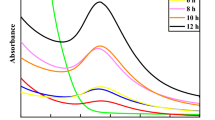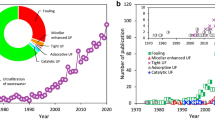Abstract
Abstract
Removal of ceftriaxone sodium antibiotic from water using cellulose acetate (CA) mixed matrix nanofiltration membranes was investigated in this work. Silica nanoparticles were functionalized with (3-aminopropyl)triethoxysilane (APTES). Then, the hydrophilic and negatively charged 2-acrylamido-2-methyl-1-propanesulfonic acid (AMPS) monomer was grafted from the surface of the amino-functionalized silica nanoparticles via surface-initiated redox polymerization. Finally, CA/silica and CA/modified silica nanocomposite membranes were prepared via phase inversion method, and the rejection of ceftriaxone sodium was studied. Rejection ratios were about 90 and 96% for CA/silica and CA/modified silica membranes at pH 8, respectively, wherein both were higher compared to the neat CA membrane. In fact, in case of nanocomposite membranes, size exclusion and charge repulsion between negatively charged functional groups of the membrane and anionic groups of drug operated synergistically at alkaline pH values, and the pharmaceutical rejection was improved.
Graphical abstract











Similar content being viewed by others
References
K. Košutić et al., Removal of antibiotics from a model wastewater by RO/NF membranes. Sep. Purif. Technol. 53(3), 244–249 (2007)
A.A. Sadmani, R.C. Andrews, D.M. Bagley, Impact of natural water colloids and cations on the rejection of pharmaceutically active and endocrine disrupting compounds by nanofiltration. J. Membr. Sci. 450, 272–281 (2014)
L. Jurecska et al., Reprint of “Characterization of cyclodextrin containing nanofilters for removal of pharmaceutical residues”. J. Pharm. Biomed. Anal. 106, 124–128 (2015)
Y.-L. Lin, C.-H. Lee, Elucidating the rejection mechanisms of PPCPs by nanofiltration and reverse osmosis membranes. Ind. Eng. Chem. Research 53(16), 6798–6806 (2014)
A. Vona et al., Comparison of different removal techniques for selected pharmaceuticals. J. Water Process Eng. 5, 48–57 (2015)
N. Le-Minh et al., Fate of antibiotics during municipal water recycling treatment processes. Water Res. 44(15), 4295–4323 (2010)
M. Homayoonfal, M.R. Mehrnia, Amoxicillin separation from pharmaceutical solution by pH sensitive nanofiltration membranes. Sep. Purif. Technol. 130, 74–83 (2014)
X. Wei et al., Advanced treatment of a complex pharmaceutical wastewater by nanofiltration: membrane foulant identification and cleaning. Desalination 251(1), 167–175 (2010)
A. Zhu et al., Recovery of clindamycin from fermentation wastewater with nanofiltration membranes. Water Res. 37(15), 3718–3732 (2003)
M.B. Martínez et al., Separation of a high-value pharmaceutical compound from waste ethanol by nanofiltration. J. Ind. Eng. Chem. 18(5), 1635–1641 (2012)
X.Q. Cheng et al., Nanofiltration membrane achieving dual resistance to fouling and chlorine for “green” separation of antibiotics. J. Membr. Sci. 493, 156–166 (2015)
W. Zhang et al., Development and characterization of composite nanofiltration membranes and their application in concentration of antibiotics. Sep. Purif. Technol. 30(1), 27–35 (2003)
A. Ben-David et al., Facile surface modification of nanofiltration membranes to target the removal of endocrine-disrupting compounds. J. Membr. Sci. 357(1), 152–159 (2010)
L.D. Nghiem, A.I. Schäfer, M. Elimelech, Pharmaceutical retention mechanisms by nanofiltration membranes. Enviro. Sci. Technol. 39(19), 7698–7705 (2005)
R.M. Narbaitz et al., Pharmaceutical and personal care products removal from drinking water by modified cellulose acetate membrane: field testing. Chem. Eng. J. 225, 848–856 (2013)
M. Sivakumar, D.R. Mohan, R. Rangarajan, Studies on cellulose acetate-polysulfone ultrafiltration membranes: II. Effect of additive concentration. J. Membr. Sci. 268(2), 208–219 (2006)
N. Ghaemi et al., Fabrication of cellulose acetate/sodium dodecyl sulfate nanofiltration membrane: characterization and performance in rejection of pesticides. Desalination 290, 99–106 (2012)
R. Abedini, S.M. Mousavi, R. Aminzadeh, A novel cellulose acetate (CA) membrane using TiO2 nanoparticles: preparation, characterization and permeation study. Desalination 277(1), 40–45 (2011)
A. Ahmad et al., Effect of silica on the properties of cellulose acetate/polyethylene glycol membranes for reverse osmosis. Desalination 355, 1–10 (2015)
H. Mahdavi, T. Shahalizade, Preparation, characterization and performance study of cellulose acetate membranes modified by aliphatic hyperbranched polyester. J. Membr. Sci. 473, 256–266 (2015)
G. Arthanareeswaran, D. Mohan, M. Raajenthiren, Preparation, characterization and performance studies of ultrafiltration membranes with polymeric additive. J. Membr. Sci. 350(1), 130–138 (2010)
G. Arthanareeswaran et al., Studies on performance of cellulose acetate and poly (ethelene glycol) blend ultrafiltration membranes using mixture design concept of design of experiments. Int. J. Polym. Mater. 55(12), 1133–1154 (2006)
V. Souza, M. Quadri, Organic-inorganic hybrid membranes in separation processes: a 10-year review. Braz. J. Chem. Eng. 30(4), 683–700 (2013)
N. Rakhshan, M. Pakizeh, The effect of functionalized SiO2 nanoparticles on the morphology and triazines separation properties of cellulose acetate membranes. J. Ind. Eng. Chem. 34, 51–60 (2016)
G. Arthanareeswaran, T.S. Devi, M. Raajenthiren, Effect of silica particles on cellulose acetate blend ultrafiltration membranes: Part I. Sep. Purif. Technol. 64(1), 38–47 (2008)
C.H. Worthley et al., A study into the effect of POSS nanoparticles on cellulose acetate membranes. J. Membr. Sci. 431, 62–71 (2013)
A. Shahtalebi, M. Sarrafzadeh, M.M. Rahmati, Application of nanofiltration membrane in the separation of amoxicillin from pharmaceutical wastewater. Iran. J. Environ. Health Sci. Eng. 8(2), 109 (2011)
C.M. Kee, A. Idris, Modification of cellulose acetate membrane using monosodium glutamate additives prepared by microwave heating. J. Ind. Eng. Chem. 18(6), 2115–2123 (2012)
L. Ahmadian-Alam, M. Kheirmand, H. Mahdavi, Preparation, characterization and properties of PVDF-g-PAMPS/PMMA-co-PAMPS/silica nanoparticle as a new proton exchange nanocomposite membrane. Chem. Eng. J. 284, 1035–1048 (2016)
P. Salarizadeh, M. Abdollahi, M. Javanbakht, Modification of silica nanoparticles with hydrophilic sulfonated polymers by using surface-initiated redox polymerization. Iran. Polym. J. 21(10), 661–668 (2012)
A.K. Hołda, I.F. Vankelecom, Understanding and guiding the phase inversion process for synthesis of solvent resistant nanofiltration membranes. J. Appl. Polymer Sci. 32(27), 42130–42147 (2015)
B. Van der Bruggen, J. Geens, C. Vandecasteele, Fluxes and rejections for nanofiltration with solvent stable polymeric membranes in water, ethanol and n-hexane. Chem. Eng. Sci. 57(13), 2511–2518 (2002)
M. Naghsh et al., Separation of ethylene/ethane and propylene/propane by cellulose acetate–silica nanocomposite membranes. J. Membr. Sci. 423, 97–106 (2012)
Author information
Authors and Affiliations
Corresponding author
Rights and permissions
About this article
Cite this article
Mahdavi, H., Bagherifar, R. Cellulose acetate/SiO2-poly(2-Acrylamido-2-methylpropane sulfonic acid) hybrid nanofiltration membrane: application in removal of ceftriaxone sodium. J IRAN CHEM SOC 15, 2839–2849 (2018). https://doi.org/10.1007/s13738-018-1470-4
Received:
Accepted:
Published:
Issue Date:
DOI: https://doi.org/10.1007/s13738-018-1470-4




